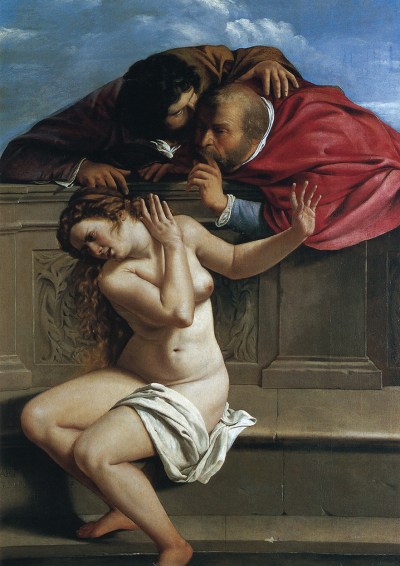A Polite Parisian Exhibition Sanitizes Artemesia Gentileschi’s Proto-Feminist Rage

Artemisia Gentileschi’s empathic and heroic portrayals of women have made her a protofeminist icon. Her works—most famously Judith Slaying Holofernes (c. 1612)—do more than transform her passive objects into active subjects; they endow them with the power to enact righteous, even vengeful violence.
Such scenes are inseparable from Artemisia’s own biography, according to Patrizia Cavazzini, co-curator of “Artemisia, Heroine of Art,” a major retrospective currently on view at the Musée Jacquemart-André in Paris. Yes, Gentileschi asserted autonomy, both in her technical mastery and in her strategic self-portraiture. But above all, she rejected the confining ideal of the “virtuous woman artist” that dominated 17th-century Italian debates over the role of women in art and society.
Born in Rome in 1593, Artemisia was the eldest of four children and the only daughter in a household headed by the painter Orazio Gentileschi. A central thread in the exhibition is the evolving relationship between Artemisia and her father. In an era when most women were denied access to artistic training, Artemisia not only received instruction and studio privileges from Orazio but was actively encouraged to paint. Her early masterpiece, Susanna and the Elders (1610), painted when she was just 17, bears only her signature—despite evidence of her father’s involvement—underscoring Orazio’s commitment to promoting her career.
Artemisia’s feminist attitudes of assertion and defiance come through in Susanna and the Elders. Drawn from the biblical story where two old men blackmail Suzanna to sleep with them, Artemisia and Orazio’s version of this oft-depicted scene groups the three figures into a tight frame. This framing effectively conveys the uncomfortable claustrophobia of sexual harassment while keeping with Caravaggesque conventions—naturalistic renderings of live models, neutral backgrounds, and stark chiaroscuro.
Two men leer at her over a stone railing; meanwhile, the painting’s nude heroine shies away, her hands raised in a gesture of protective revulsion. Scholars have argued that the scene captures something of Artemisia’s feminine perspective, pointing to Susanna’s expressive gestures and posture as convincingly portraying the discomfort of sexual aggression—as if Artemesia were painting from experience rather than imagination.
The exhibition juxtaposes Orazio’s (ca. 1612) and Artemisia’s (ca. 1615) Judith and Her Maidservant paintings. Both works capture a tense moment following Judith’s decapitation of Holofernes, but Artemisia’s version offers a more forceful heroine, richer textiles, and a gesture of solidarity between Judith and her servant that her father’s painting lacks. It marks the emergence of Artemisia’s own sensibility, one more intimate, more psychologically charged, and often more brutal than her father’s.

Susannah and the Elders, 1610.
Judith recurs throughout Artemisia’s oeuvre, along with Esther and Jael, other biblical heroines displaying cunning, strength, and moral ambiguity. Her most famous work is Judith Slaying Holoferenes (c. 1612)—mid- rather than post-decapitation—thanks to Mary Garrard’s 1989 interpretation of this image as a psychological purging of Artemisia’s rape, perpetrated by her father’s colleague Agonstino Tassi. The exhibition features not Gentileschi’s original but a 17th-century copy from Bologna, testifying to the image’s influence and proliferation.
This rape figures prominently in narratives of Gentileschi’s life, in part because there is a historical record of it. Orazio brought charges, and the trial became a public spectacle. Artemisia was tortured with thumbscrews to verify her testimony; Tassi was convicted, not for rape—which wasn’t considered a crime unto itself—but for failing to marry her afterward. Protected by patrons like Cardinal Scipione Borghese, Tassi served only a few months in exile before returning to Rome.
Artemisia later married the painter Pierantonio Stiattesi and settled in Florence, where she entered the intellectual circles of the Medici court and the Buonarroti family. Florence was where Artemisia rebuilt and grew, both artistically and psychologically. She learned to read and write, studied music, and painted self-portraits. In Self-Portrait as a Lute Player (1614–15) and others from the 1620s, Artemisia exudes confidence, sensuality, self-possession, and above all, mastery— over both her image and her medium.
Her portraits of others—knights, noblemen, scholars—cemented her place within Florence’s and later Rome’s elite, where she returned in 1620. In the Eternal City, her circle included expatriate artists like Leonaert Bramer, who playfully sketched her in drag. Far from ridicule, it was a gesture of camaraderie. She became “one of the boys” to her credit rather than to her detriment. Artemisia was affiliated with the Bentvueghels, a group of rebellious artists in Rome known for their irreverence, drunkenness, and disdain for the academic establishment. She was reportedly their only female member and the only Italian—an iconoclast even among iconoclasts.

The exhibition excels in narrating the artist’s fascinating biography, but its final sections, focused on mythology and allegory, feel weaker by comparison. These galleries feature recently attributed works and paintings from private collections that are rarely seen, though not all of them are great. One such example, John the Baptist in the Desert (1630s), is sober, almost mannerist and, in my opinion, strays too far from the visceral naturalism of the Caravaggesque tradition and from the populist energy that animates her most powerful work. More compelling is the Penitent Magdalene (c. 1625) from the Cathedral of Seville, a portrait of luminous restraint, boasting soft, flushed skin and contemplative melancholy rendered with unusual precision. In contrast to other works characterized by overworked sfumato and melodrama, Magdalene’s tranquil clarity and precision is refreshing.
Artemisia’s story offers revealing clues not only with regard to the past but to the contradictions of the present. The exhibition reflects both a cultural hunger for feminist recovery and an art market eager to capitalize on narratives of resistance and rediscovery. Yet it raises a pressing question: can a private institution like the Jacquemart-André, steeped in bourgeois refinement, do justice to a figure as uncompromising as Artemisia? Does displaying her work in plush interiors aestheticize her trauma, blunt her sharp edges? The tension between institutional politeness and feminist rage hums faintly, just beneath the surface. Artemisia’s legacy lies not merely in her biography or technical mastery, but in her confrontational refusal to flinch.



